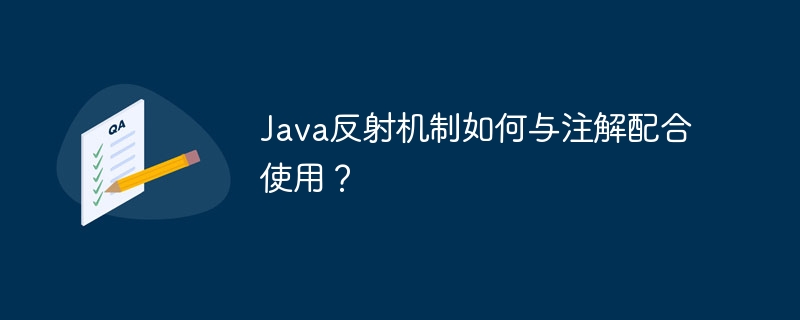Home >Java >javaTutorial >How does the Java reflection mechanism work with annotations?
How does the Java reflection mechanism work with annotations?
- 王林Original
- 2024-05-03 18:54:01751browse
The Java reflection mechanism and annotations are powerfully combined to achieve code flexibility, maintainability and reusability. The reflection mechanism is used to dynamically process class information, such as loading classes, creating objects, and obtaining type information; annotations append metadata to provide additional information. Used together, it can be achieved: Dynamic annotation processing: The reflection mechanism processes annotations, checks existence or extracts values. Introspection: The reflection mechanism analyzes class structure and behavior to understand annotation information. Dynamic code generation: The reflection mechanism works with annotations to generate code, such as creating proxy classes or interceptors.

Java reflection mechanism and annotations: a practical case of strong alliance
Introduction
Java reflection and annotations are powerful tools that, when used together, enable excellent code flexibility, maintainability, and reusability. This article will delve into how the reflection mechanism cooperates with annotations, and demonstrate its application through a practical case.
Introduction to the reflection mechanism
The Java reflection mechanism allows programs to inspect and operate information on Java elements such as classes, fields, and methods at runtime. It provides a powerful API for dynamically loading classes, creating objects, calling methods, and obtaining type information.
Introduction to Annotations
Annotations are a type of metadata used to attach information to code elements such as classes, methods, and fields. They are included before the class definition, starting with the @ symbols. Annotations can store various information such as author name, method purpose, or field default value.
Cooperation of reflection mechanism and annotations
The powerful combination of reflection mechanism and annotations can achieve many useful functions:
- Dynamic annotation processing: The reflection mechanism can be used to process annotations at runtime, such as checking whether an annotation exists or extracting annotation values.
- Introspection: The reflection mechanism can be used to analyze classes and their annotations to understand their structure and behavior.
- Dynamic code generation: The reflection mechanism can work with annotations to generate dynamic code, such as creating proxy classes or interceptors based on annotation metadata.
Practical case
Let us use a practical case to illustrate how the reflection mechanism cooperates with annotations. We will create a class that marks the method with the @Log annotation so that its name is logged when the method is called.
import java.lang.annotation.ElementType;
import java.lang.annotation.Retention;
import java.lang.annotation.RetentionPolicy;
import java.lang.annotation.Target;
import java.lang.reflect.InvocationHandler;
import java.lang.reflect.Method;
import java.lang.reflect.Proxy;
@Target(ElementType.METHOD)
@Retention(RetentionPolicy.RUNTIME)
public @interface Log {
}
public class Main {
private static void logMethodCall(Object proxy, Method method, Object[] args) {
System.out.println("Calling method: " + method.getName());
}
public static Object createLoggingProxy(Object object) {
return Proxy.newProxyInstance(object.getClass().getClassLoader(),
object.getClass().getInterfaces(),
(proxy, method, args) -> {
logMethodCall(proxy, method, args);
return method.invoke(object, args);
});
}
public static void main(String[] args) {
MessageService messageService = (MessageService) createLoggingProxy(new MessageServiceImpl());
messageService.sendMessage("Hello, world!");
}
public interface MessageService {
void sendMessage(String message);
}
public static class MessageServiceImpl implements MessageService {
@Override
public void sendMessage(String message) {
System.out.println("Sending message: " + message);
}
}
}In this case, the @Log annotation is used to mark the sendMessage method in the MessageServiceImpl class. We use the reflection mechanism to create a proxy class that triggers the logMethodCall method to record the method name when the method is called.
After running the code, the output looks like this:
Calling method: sendMessage Sending message: Hello, world!
In this example, we see how the reflection mechanism and annotations can be used together to achieve dynamic code generation and code introspection.
The above is the detailed content of How does the Java reflection mechanism work with annotations?. For more information, please follow other related articles on the PHP Chinese website!
Related articles
See more- Definition of reflection mechanism and three methods of obtaining Class
- What is Java reflection? Detailed introduction to Java reflection mechanism
- Get function documentation using PHP reflection mechanism
- What is the principle of Java's reflection mechanism?
- Reflection mechanism and its applications in PHP

